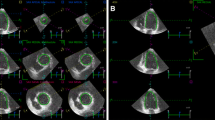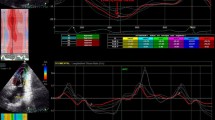Abstract
To assess the value of three-dimensional speckle tracking echocardiography (3D STE) in evaluating the left ventricular (LV) function in hyperuricemia patients. We enrolled 15 healthy controls and 40 hyperuricemia patients and collected and analyzed full-volume 3D STE images of the left ventricle in the apical four-chamber heart view. Laboratory tests and 3D STE parameters, including left ventricular ejection fraction, left ventricular end-diastolic volume, left ventricular end-systolic volume, stroke volume (SV), global longitudinal strain (GLS), and global circumferential strain (GCS), were compared between hyperuricemia patients and healthy controls. Hyperuricemia patients exhibited higher body mass index (24.70 ± 2.9 vs. 21.83 ± 2.4 kg/m2, p = 0.001), C-reactive protein (5.82 ± 9.4 vs. 1.12 ± 1.8 g/L, p = 0.012), alanine transaminase (34.26 ± 26.6 vs. 17.60 ± 13.0 U/L, p = 0.011), aspartate transaminase (24.90 ± 11.3 vs. 17.70 ± 4.1 U/L, p = 0.001), blood urea nitrogen (5.11 ± 1.6 vs. 4.18 ± 0.6 mmol/L, p = 0.046), and serum creatinine (90.25 ± 14.6 vs. 77.93 ± 10.8 μmol/L, p = 0.006) levels, as well as a lower estimated glomerular filtration rate (87.87 ± 16.5 vs. 103.64 ± 11.3 mL/min/1.73m2, p = 0.002). The 3D STE parameters reflecting LV function, including SV (54.71 ± 9.6 vs. 61.92 ± 14.4 mL, p = 0.024), GLS (− 20.51 ± 4.0 vs. − 23.20 ± 4.0%, p = 0.019), and GCS (− 31.30 ± 5.0 vs. − 35.65 ± 2.5%, p = 0.000), were significantly decreased in hyperuricemia patients. Furthermore, GCS was significantly correlated with the serum uric acid (sUA) level even after adjustment of confounding variables like age, body mass index, and serum creatinine. 3D STE is a novel technique for recognizing the early decline in LV function, with GLS and GCS serving as reliable indicators, in hyperuricemia patients. Moreover, the degree of decline in LV function may be correlated with the sUA level in hyperuricemia patients.

Similar content being viewed by others
References
Liu R, Han C, Wu D, Xia X, Gu J, Guan H, Shan Z, Teng W (2015) Prevalence of hyperuricemia and gout in mainland China from 2000 to 2014: a systematic review and meta-analysis. Biomed Res Int 2015:762820. https://doi.org/10.1155/2015/762820
Kuo CF, Yu KH, See LC, Chou IJ, Ko YS, Chang HC, Chiou MJ, Luo SF (2013) Risk of myocardial infarction among patients with gout: a nationwide population-based study. Rheumatology 52(1):111–117. https://doi.org/10.1093/rheumatology/kes169
Rock KL, Kataoka H, Lai JJ (2013) Uric acid as a danger signal in gout and its comorbidities. Nat Rev Rheumatol 9(1):13–23. https://doi.org/10.1038/nrrheum.2012.143
Bonakdaran S, Kharaqani B (2014) Association of serum uric acid and metabolic syndrome in type 2 diabetes. Curr Diabetes Rev 10(2):113–117
Sharaf El Din UAA, Salem MM, Abdulazim DO (2017) Uric acid in the pathogenesis of metabolic, renal, and cardiovascular diseases: a review. J Adv Res 8(5):537–548. https://doi.org/10.1016/j.jare.2016.11.004
Alderman MH, Cohen H, Madhavan S, Kivlighn S (1999) Serum uric acid and cardiovascular events in successfully treated hypertensive patients. Hypertension 34(1):144–150
Verdecchia P, Schillaci G, Reboldi G, Santeusanio F, Porcellati C, Brunetti P (2000) Relation between serum uric acid and risk of cardiovascular disease in essential hypertension. The PIUMA study. Hypertension 36(6):1072–1078
Bos MJ, Koudstaal PJ, Hofman A, Witteman JC, Breteler MM (2006) Uric acid is a risk factor for myocardial infarction and stroke: the Rotterdam study. Stroke 37(6):1503–1507. https://doi.org/10.1161/01.STR.0000221716.55088.d4
Krishnan E, Baker JF, Furst DE, Schumacher HR (2006) Gout and the risk of acute myocardial infarction. Arthritis Rheum 54(8):2688–2696. https://doi.org/10.1002/art.22014
Zhu Y, Pandya BJ, Choi HK (2012) Comorbidities of gout and hyperuricemia in the US general population: NHANES 2007-2008. Am J Med 125(7):679–687 e671. https://doi.org/10.1016/j.amjmed.2011.09.033
Dai XM, Wei L, Ma LL, Chen HY, Zhang ZJ, Ji ZF, Wu WL, Ma LY, Kong XF, Jiang LD (2015) Serum uric acid and its relationship with cardiovascular risk profile in Chinese patients with early-onset coronary artery disease. Clin Rheumatol 34(9):1605–1611. https://doi.org/10.1007/s10067-015-2878-1
Seo Y, Ishizu T, Atsumi A, Kawamura R, Aonuma K (2014) Three-dimensional speckle tracking echocardiography. Circ J 78(6):1290–1301
Fang J, Alderman MH (2000) Serum uric acid and cardiovascular mortality the NHANES I epidemiologic follow-up study, 1971-1992. National Health and Nutrition Examination Survey. JAMA 283(18):2404–2410
Stevens PE, Levin A, Kidney Disease: Improving Global Outcomes Chronic Kidney Disease Guideline Development Work Group M (2013) Evaluation and management of chronic kidney disease: synopsis of the kidney disease: improving Global Outcomes 2012 Clinical Practice Guideline. Ann Intern Med 158(11):825–830. https://doi.org/10.7326/0003-4819-158-11-201306040-00007
Seo Y, Ishizu T, Aonuma K (2014) Current status of 3-dimensional speckle tracking echocardiography: a review from our experiences. J Cardiovasc Ultrason 22(2):49–57. https://doi.org/10.4250/jcu.2014.22.2.49
Gertler MM, Garn SM, Levine SA (1951) Serum uric acid in relation to age and physique in health and in coronary heart disease. Ann Intern Med 34(6):1421–1431
Wu AH, Gladden JD, Ahmed M, Ahmed A, Filippatos G (2016) Relation of serum uric acid to cardiovascular disease. Int J Cardiol 213:4–7. https://doi.org/10.1016/j.ijcard.2015.08.110
Culleton BF, Larson MG, Kannel WB, Levy D (1999) Serum uric acid and risk for cardiovascular disease and death: the Framingham Heart Study. Ann Intern Med 131(1):7–13
Jayashankar CA, Andrews HP, Vijayasarathi, Pinnelli VB, Shashidharan B, Nithin Kumar HN, Vemulapalli S (2016) Serum uric acid and low-density lipoprotein cholesterol levels are independent predictors of coronary artery disease in Asian Indian patients with type 2 diabetes mellitus. J Nat Sci Biol Med 7(2):161–165. https://doi.org/10.4103/0976-9668.184703
Huang H, Huang B, Li Y, Huang Y, Li J, Yao H, Jing X, Chen J, Wang J (2014) Uric acid and risk of heart failure: a systematic review and meta-analysis. Eur J Heart Fail 16(1):15–24. https://doi.org/10.1093/eurjhf/hft132
Zhu Y, Hu Y, Huang T, Zhang Y, Li Z, Luo C, Luo Y, Yuan H, Hisatome I, Yamamoto T, Cheng J (2014) High uric acid directly inhibits insulin signalling and induces insulin resistance. Biochem Biophys Res Commun 447(4):707–714. https://doi.org/10.1016/j.bbrc.2014.04.080
Kirca M, Oguz N, Cetin A, Uzuner F, Yesilkaya A (2017) Uric acid stimulates proliferative pathways in vascular smooth muscle cells through the activation of p38 MAPK, p44/42 MAPK and PDGFRbeta. J Recept Signal Transduct Res 37(2):167–173. https://doi.org/10.1080/10799893.2016.1203941
Puddu P, Puddu GM, Cravero E, Vizioli L, Muscari A (2012) Relationships among hyperuricemia, endothelial dysfunction and cardiovascular disease: molecular mechanisms and clinical implications. J Cardiol 59(3):235–242. https://doi.org/10.1016/j.jjcc.2012.01.013
Tsushima Y, Nishizawa H, Tochino Y, Nakatsuji H, Sekimoto R, Nagao H, Shirakura T, Kato K, Imaizumi K, Takahashi H, Tamura M, Maeda N, Funahashi T, Shimomura I (2013) Uric acid secretion from adipose tissue and its increase in obesity. J Biol Chem 288(38):27138–27149. https://doi.org/10.1074/jbc.M113.485094
Dessein PH, Shipton EA, Stanwix AE, Joffe BI, Ramokgadi J (2000) Beneficial effects of weight loss associated with moderate calorie/carbohydrate restriction, and increased proportional intake of protein and unsaturated fat on serum urate and lipoprotein levels in gout: a pilot study. Ann Rheum Dis 59(7):539–543
Busso N, So A (2012) Microcrystals as DAMPs and their role in joint inflammation. Rheumatology 51(7):1154–1160. https://doi.org/10.1093/rheumatology/ker524
Crisan TO, Cleophas MCP, Novakovic B, Erler K, van de Veerdonk FL, Stunnenberg HG, Netea MG, Dinarello CA, Joosten LAB (2017) Uric acid priming in human monocytes is driven by the AKT-PRAS40 autophagy pathway. Proc Natl Acad Sci U S A 114(21):5485–5490. https://doi.org/10.1073/pnas.1620910114
Jolly SE, Mete M, Wang H, Zhu J, Ebbesson SO, Voruganti VS, Comuzzie AG, Howard BV, Umans JG (2012) Uric acid, hypertension, and chronic kidney disease among Alaska Eskimos: the Genetics of Coronary Artery Disease in Alaska Natives (GOCADAN) study. J Clin Hypertens 14(2):71–77. https://doi.org/10.1111/j.1751-7176.2011.00574.x
Liu H, Zhang XM, Wang YL, Liu BC (2014) Prevalence of hyperuricemia among Chinese adults: a national cross-sectional survey using multistage, stratified sampling. J Nephrol 27(6):653–658. https://doi.org/10.1007/s40620-014-0082-z
Hare JM, Mangal B, Brown J, Fisher C Jr, Freudenberger R, Colucci WS, Mann DL, Liu P, Givertz MM, Schwarz RP, Investigators O-C (2008) Impact of oxypurinol in patients with symptomatic heart failure. Results of the OPT-CHF study. J Am Coll Cardiol 51(24):2301–2309. https://doi.org/10.1016/j.jacc.2008.01.068
Funding
This work was supported by National Natural Science Foundation of China (KRF301134/001).
Author information
Authors and Affiliations
Corresponding author
Ethics declarations
The study protocol was approved by the ethics committee of Zhongshan Hospital, Fudan University (Shanghai, China). All patients and healthy controls provided written informed consent to participate in the study.
Disclosures
None.
Rights and permissions
About this article
Cite this article
Zhang, X., Lu, Q., Zhang, Z. et al. Value of three-dimensional speckle tracking echocardiography to assess left ventricular function in hyperuricemia patients. Clin Rheumatol 37, 2539–2545 (2018). https://doi.org/10.1007/s10067-018-4132-0
Received:
Revised:
Accepted:
Published:
Issue Date:
DOI: https://doi.org/10.1007/s10067-018-4132-0




